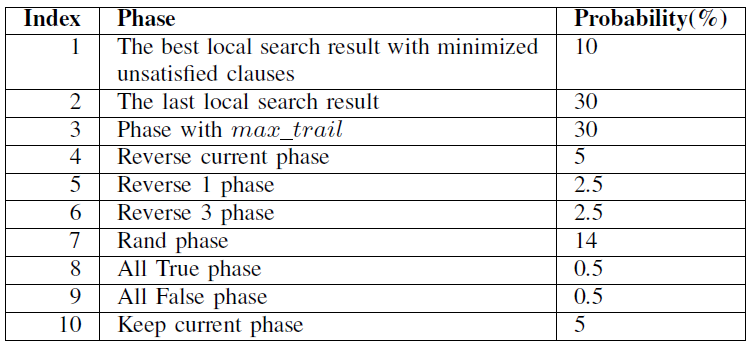作者:
Xindi Zhang1,2 and Shaowei Cai1,2*
1State Key Laboratory of Computer Science, Institute of Software, Chinese Academy of Sciences, Beijing, China
2School of Computer Science and Technology, University of Chinese Academy of Sciences, China
dezhangxd@163.com, shaoweicai.cs@gmail.com
要点:
-
- 一种新的弛豫CDCL方法
- 基于概率的相位节约技术
| Abstract | |
|
Abstract—A novel relaxing CDCL method and a new probability based phase saving technology are described. 译文:介绍了一种新的弛豫CDCL方法和一种新的基于概率的相位节约技术。
|
|
| I. INTRODUCTION | |
|
We improve the relaxing CDCL method [3] using the information in CCAnr [2] this year. By using some full assignments (also named phases) with certain probability before each inprocessing, the performance of solvers on satisfiable instances are improved. 译文:通过在每次处理前使用一定概率的完全赋值(也称为相位),提高了求解器在可满足实例上的性能。 |
|
| II. METHODS | |
| A. Relaxed CDCL Approach | |
|
The idea is to relax the backtracking process for protecting promising partial assignment, where a promising assignment is defined according to its consistency (no conflict) and length. 译文:其思想是放松回溯过程,以保护有希望的部分分配,其中有希望的分配是根据其一致性(无冲突)和长度定义的。
译文:当CDCL进程到达具有某些条件的节点时,算法进入一个非回溯阶段,直到它获得一个完整的赋值.
Then Local search process is then called to seek for a model near. 译文:然后调用局部搜索过程来寻找附近的模型.
If the local search fails to find a model within certain limits, then the algorithm goes back to the normal CDCL search from the node where it was interrupted. 译文:如果本地搜索在一定范围内无法找到模型,那么算法从被中断的节点返回到正常的CDCL搜索. |
|
|
For a given conjunctive normal formula (CNF) with V variables, |V| denotes the number of variables. And for a partial assignment α in CDCL process without conflicts, |α| is the number of assigned variables in α, then we name the max number of |α| in CDCL history as max trail. |
|
|
Here we control the entrance of local search process by p, q and c, where p, q presents |α|/|V | and |α|/max trail. And c presents the inprocessing times between two local search process. |
|
| B. Probability Based Phase Saving | |
|
Phase saving is a well-known technique which saves the assignment of variables when traceback and uses the assignment when variables are selected as decision variables. Like the rephase technique in CaDiCaL [1], we use vectors to save different phases, the difference is that we use probability to select which phase to use after each restart. The probability of each phase is shown in “Table. I” |
|
|
TABLE I
|
|
| III. IMPLEMENTATION AND MAIN PARAMETERS | |
| A. Relaxed LCMDCBDL | |
|
Relaxed LCMDCBD use both methods mentioned above and for the relaxing method, algorithms call local search process when p ≥0.4 or q ≥ 0.9 and c≥400. |
|
| B. Relaxed LCMDCBDL noTimeParam | |
|
We find there is a switch in MapleLCMDistChronoBT-DL between VSIDS and CHB when the time reach 2500 seconds, this method will make the results unstable when tested on different clusters, or even on the same clusters but at different For the stableness, we replace the time based switch with a restart based switch, i.e., every n inprocessing, the algorithm will switch the branching algorithm once between VSIDS and LRB. For our solvers, n = 500. |
|
| C. Relaxed LCMDCBDL newTech | |
|
For better utilize the information in Local Search process, we use a vector occ_num to record the number of occurrences of variables in unsat clauses after each flip. And we see one percent of occurrences as one conflict in CDCL process. |
|
|
For example, there is a CNF with two clauses {v1, x2}, {v2, v3}, which show up in the unsat clauses 10 and 20 times respectively. Assume the Local Search process conducts 100 flips, then occ num[v1] = 10, occ num[v2] = 30, occ num[v3] = 20, and v1, v2, v3 are considered as encountering 10, 30 and 20 conflicts respectively. When the Local Search process ends, the branching heuristic algorithm will utilize the information. |
|
|
Relaxed LCMDCBDL newTech adjusts the local search entrance condition to c ≥ 300 in order to adapt the local search information. |
|
| IV. ACKNOWLEDGEMENT | |
| This work was supported by Beijing Academy of Artificial Intelligence (BAAI), and Youth Innovation Promotion Association, Chinese Academy of Sciences [No. 2017150]. | |
| REFERENCES | |
|
[1] A. Biere. Cadical at the sat race 2019. SAT RACE 2019, page 8.
|
|




 浙公网安备 33010602011771号
浙公网安备 33010602011771号